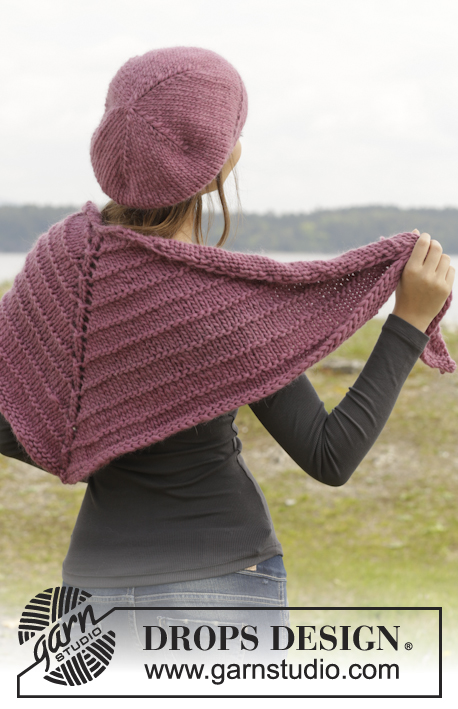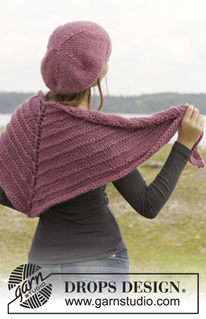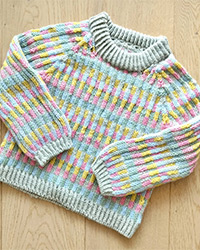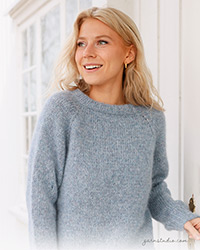Comments / Questions (57)
![]() Nina wrote:
Nina wrote:
Hei! Kunne jeg tovet denne bereten? Eller vil det se rart ut?
21.06.2024 - 02:49DROPS Design answered:
Hei Nina, Etter toving blir bereten mindre i størrelse og mye tettere. Hvis du skal ha samme fasongen, må den strikkes større og deretter trekkes ut til riktig fasong etter toving. God fornøyelse!
21.06.2024 - 06:46
![]() Monique wrote:
Monique wrote:
Puis je remplacer le point mousse du début par des côtes 2/2 ?
06.05.2024 - 22:11DROPS Design answered:
Bonjour Monique, probablement mais il faudra peut être ajuster le nombre de mailles pour avoir un multiple de 4 d'une part - pensez aussi que les côtes resserrent davantage l'ouvrage que le point mousse, il vous faudra peut être ajuster aussi le nombre de mailles en conséquence, vous pouvez essayer pour voir si le résultat vous convient. Bon tricot!
07.05.2024 - 07:47
![]() Elisabeth wrote:
Elisabeth wrote:
Bonjour, le point mousse en bordure autour du châle se fait à la fin en relevant des mailles ? En suivant les explications , je n’obtiens que du jersey avec2 rangs de points mousse dans le travail. Merci pour votre aide
12.02.2023 - 08:44DROPS Design answered:
Bonjour Elisabeth, le châle se tricote de haut en bas, en jersey avec une côte mousse à intervalles réguliers, et on le termine une côte mousse) puis 2 rangs endroit, on a ainsi 2 côtes mousse avant de rabattre, comme sur la photo. Bon tricot!
13.02.2023 - 09:38
![]() Elisabeth wrote:
Elisabeth wrote:
Bonjour, je n’arrive pas à voir le point mousse sur les bords du chale.
04.02.2023 - 11:56DROPS Design answered:
Bonjour Elisabeth, peut-être parce que les photos ne montrent pas vraiment les côtés de l'ouvrage? On tricote le châle de haut en bas, les mailles lisières au point mousse se trouvent donc dans la base en haut du triangle et on tricote en jersey avec une côte mousse ( au rang 6 des rangs 2 à 7). Bon tricot!
06.02.2023 - 15:26
![]() Cristina wrote:
Cristina wrote:
Hallo, was bedeutet das: DROPS Design 12.09.2019 kl. 20:22: Buonasera Ilaria, i modelli a maglia andrebbero sempre bloccati dopo il lavaggio. Buon lavoro! Danke Cristina
10.10.2020 - 16:11DROPS Design answered:
Liebe Cristina, die fertige Strickstücke werden immer gespannt. ( mit Stecknadeln auf einer geeigneten Unterlage spannen, anfeuchten (z.B. mit einer Sprühflasche für Blumen) und trocknen lassen, danach entfernen Sie die Stecknadeln). Viel Spaß beim stricken!
12.10.2020 - 07:49
![]() Diane wrote:
Diane wrote:
This is the worst pattern I’ve ever knitted. It doesn’t tell where the middle stitch is, row 1 has more instructions than there are available stitches. It’s terrible! I’m disappointed, I bought all the yarn I needed and the pattern is just really bad. Also, no way to get help. I will never again buy a pattern from your company.
09.09.2020 - 05:15DROPS Design answered:
Dear Diane, we are very sorry to hear that you got so many worries with this pattern, you are always welcome to ask your question here in this section to get helped - your DROPS store can always help you too - and you can also ask more knitters around the world in our DROPS Workshop. Row 1 on shawl is worked over 9 sts, you increase 4 sts = there are 13 sts at the end of this row. Hope this could help you to start. Happy knititng!
09.09.2020 - 09:28
![]() Holly wrote:
Holly wrote:
Hello! When knitting just the beret, do you just need circular needles, or do you also need double pointed needles? If the double pointed needles are needed, at what point would they be used? Thanks!
12.01.2020 - 01:50DROPS Design answered:
Hi Holly, You will need the double pointed needles at the top of the beret, when you have decreased so many stitches that the circular needle is too long. Happy knitting!
13.01.2020 - 07:25
![]() Ilaria wrote:
Ilaria wrote:
Grazie mille!
12.09.2019 - 20:28
![]() Ilaria wrote:
Ilaria wrote:
Salve!! Ho realizzato entrambi i capi del modello e volevo sapere.. lo scialle va bloccato?
12.09.2019 - 18:53DROPS Design answered:
Buonasera Ilaria, i modelli a maglia andrebbero sempre bloccati dopo il lavaggio. Buon lavoro!
12.09.2019 - 20:22
![]() Katt wrote:
Katt wrote:
I have come into a problem with the beret pattern. It says to add 5 stitch markers and decrease a stitch before and after each marker resulting in 8 sts decreased. If you are including the bor marker in the decreases it would be 10 sts decreased. So I have skipped the bor stitch decreases but now it has one side of the beret all flat with no decrease...help!!!!
12.03.2019 - 04:50DROPS Design answered:
Dear Katt, you decrease a total of 10 sts on every decrease round (2 sts at each of the 5 markers), and repeat these decreases on every other round a total of 8 times (= a total of 8 rounds with decreases). Happy knitting!
12.03.2019 - 10:10
Winter Blush#winterblushset |
|
 |
 |
Knitted DROPS beret and shawl in garter st and stockinette st in ”Snow” or "Andes".
DROPS 156-49 |
|
|
TIP FOR CHANGING YARN: When changing ball, divide the old strand in two the last 15 cm / 6" – cut one part off, do the same on the new thread. Place the first and last 15 cm / 6" over each other to get normal thickness of yarn and continue working - do this to avoid visible yarn change. GARTER ST (in the round on circular needle): * K 1 round and P 1 round *, repeat from *-*. 1 ridge = 2 rounds. INCREASE TIP: Inc 1 st by working 2 sts in 1 st. I.e. work in back and front loop of st. DECREASE TIP: Dec 1 st before marker as follows: Work until 2 sts remain before marker, slip 1 st as if to K, K 1, psso. Dec 1 st after marker as follows: K 2 tog. ---------------------------------------------------------- BERET: Worked in the round on circular needle and double pointed needles. Loosely cast on 45 sts on circular needle size 6 mm / US 10 with Snow. Work in GARTER ST – see explanation above – until piece measures 6 cm / 2⅜". REMEMBER THE GAUGE! On next round inc 1 st in every st - see INCREASE TIP = 90 sts on needle. Continue in stockinette st. When piece measures 16 cm / 6¼", insert 5 markers in the piece as follows: Insert 1st marker at the beg of the round. Then insert 1 marker for every 18 sts = 5 markers. Then continue in stockinette st while AT THE SAME TIME dec every other round as follows: Dec 1 st on each side of every marker 8 times in total - see DECREASE TIP = 10 sts remain. Pull yarn through the remaining 10 sts, tighten tog and fasten. ----------------------------------------------------------- SHAWL: Worked back and forth on circular needle. READ TIP FOR CHANGING YARN! Cast on 9 sts on circular needle size 8 mm / US 11 with Snow. Work as follows: ROW 1 (= RS): K 1, 1 YO, K 3, 1 YO, K 1 (= mid st) insert a marker in this st, 1 YO, K 3, 1 YO and K 1 = 13 sts. ROW 2 (= WS): P 1, 1 YO, P until 1 st remains, 1 YO and P 1 = 2 sts inc. ROW 3: K 1, 1 YO, K until mid st, 1 YO, K 1 (= mid st), 1 YO, K until 1 st remains, 1 YO and K 1 = 4 sts inc. REMEMBER THE GAUGE! ROW 4: P 1, 1 YO, P until 1 st remains, 1 YO and P 1 = 2 sts inc. ROW 5: K 1, 1 YO, K until mid st, 1 YO, K 1 (= mid st), 1 YO, K until 1 st remains, 1 YO and K 1 = 4 sts inc. ROW 6: K 1, 1 YO, K until 1 st remains, 1 YO and K 1 = 2 sts inc. ROW 7: K 1, 1 YO, K until mid st, 1 YO, K 1 (= mid st), 1 YO, K until 1 st remains, 1 YO and K 1 = 4 sts inc. Repeat rows 2 - 7 until piece measures approx. 45 cm = 17¾" over mid st – adjust so that last row is 7th row with K sts and inc. K 1 row from wrong side and bind off loosely on next row from right side. |
|
Have you finished this pattern?Tag your pictures with #dropspattern #winterblushset or submit them to the #dropsfan gallery. Do you need help with this pattern?You'll find 20 tutorial videos, a Comments/Questions area and more by visiting the pattern on garnstudio.com. © 1982-2025 DROPS Design A/S. We reserve all rights. This document, including all its sub-sections, has copyrights. Read more about what you can do with our patterns at the bottom of each pattern on our site. |
|






















































Post a comment to pattern DROPS 156-49
We would love to hear what you have to say about this pattern!
If you want to leave a question, please make sure you select the correct category in the form below, to speed up the answering process. Required fields are marked *.